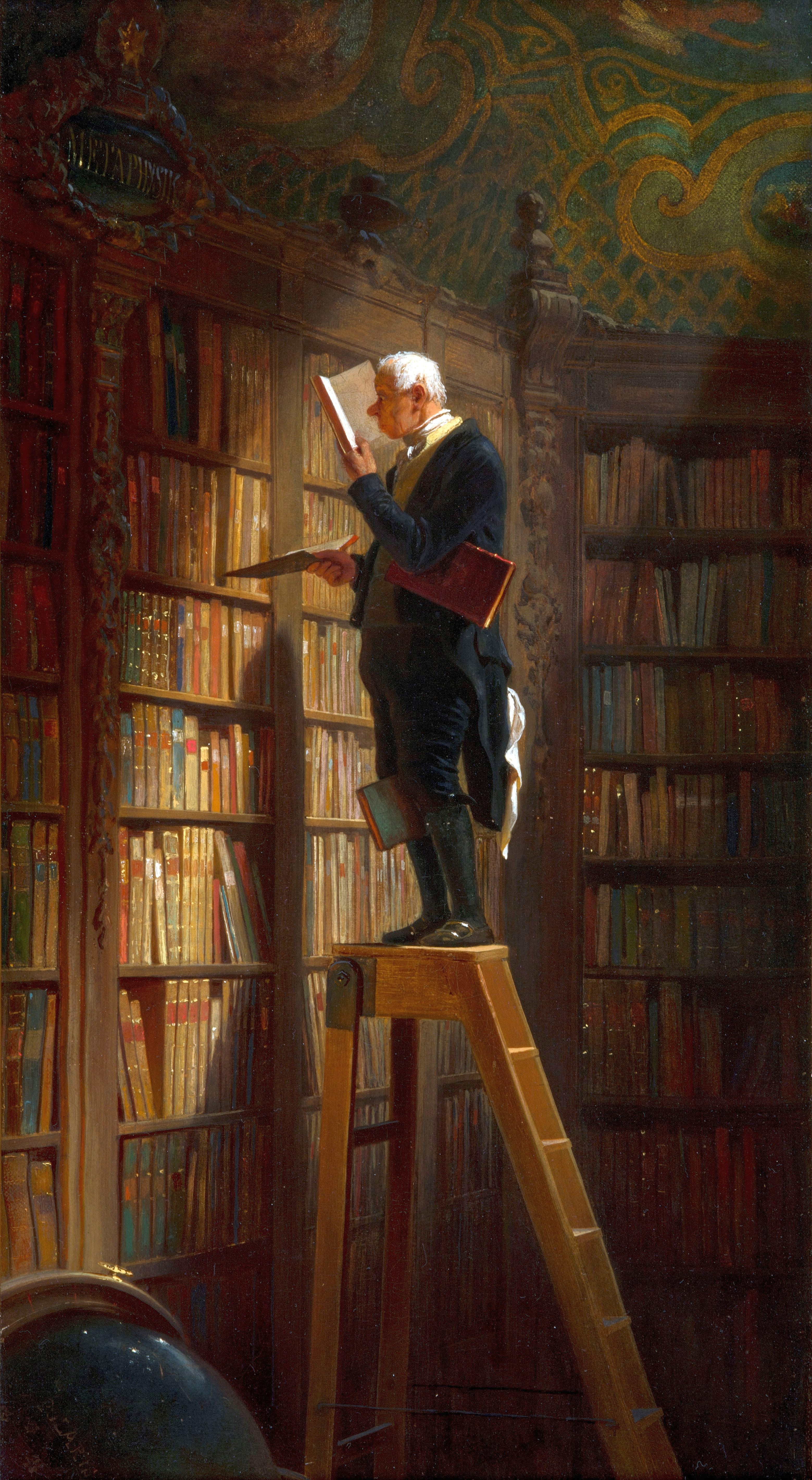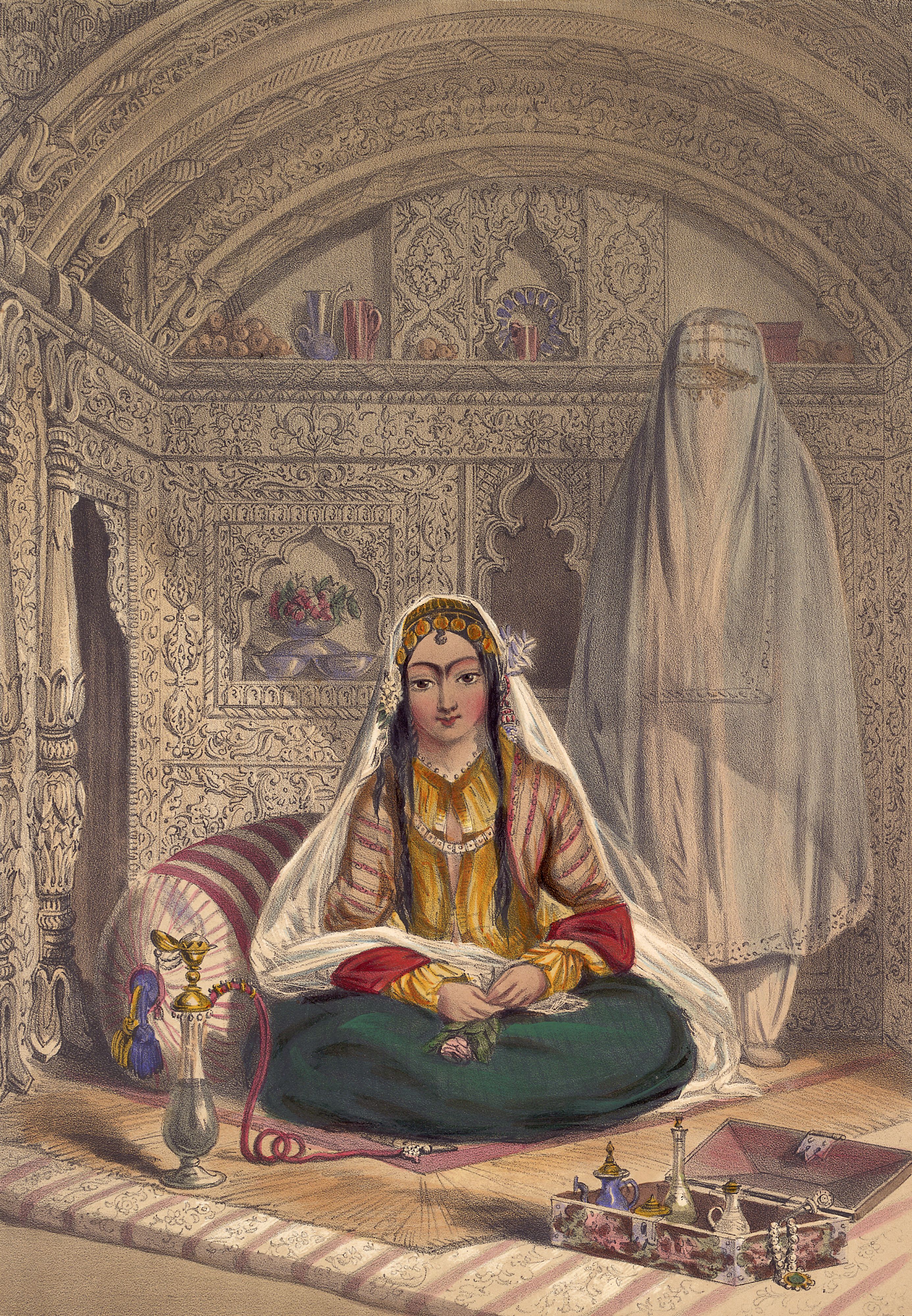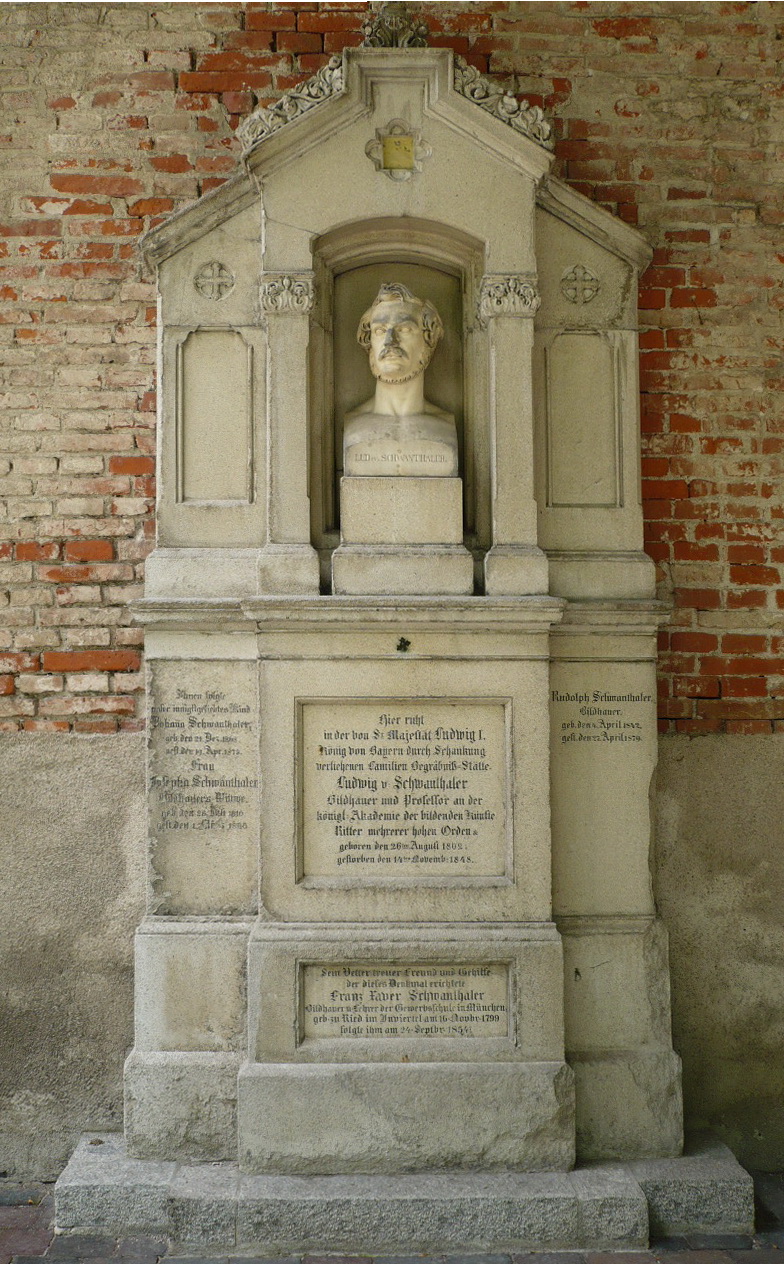|
Carl Spitzweg
Carl Spitzweg (February 5, 1808 – September 23, 1885) was a German romanticist painter, especially of genre subjects. He is considered to be one of the most important artists of the Biedermeier era. Life and career Spitzweg was born in Unterpfaffenhofen, near Munich, Bavaria, the second of three sons of Franziska (née Schmutzer) and Simon Spitzweg. His father, a wealthy merchant, had Carl trained as a pharmacist. He attained his qualification from the University of Munich but, while recovering from an illness, he took up painting. Spitzweg was self-taught as an artist, starting out by copying the works of Flemish masters. He contributed his first work to satiric magazines. Upon receiving an inheritance in 1833, he was able to dedicate himself to painting. Later, Spitzweg visited European art centers in Prague, Venice, Paris, London, and Belgium studying the works of various artists and refining his technique and style. His later paintings and drawings are often humorous ... [...More Info...] [...Related Items...] OR: [Wikipedia] [Google] [Baidu] |
Germering
Germering ( Central Bavarian: ''Geamaring'') is a town of approximately 40,500 within the district of Fürstenfeldbruck, in Bavaria, Germany. It is directly adjacent to the city of Munich and borders it to the west. History The area of Germering has an old history attested by findings of burial mounds of the New Stone Age and the Bronze Age, as well as a "villa rustica" (as in nearby Leutstetten) built by the Romans. There was a trade route through the city with numerous brick kilns. After their discovery a glass roof was erected over one (near the Nebelerstrasse) so one can still view it. Germering was first reliably mentioned about 859-864 A.D. In those days it was still known as ''Kermeringon'', but apparently it was formerly mentioned under the name ''Germana vel admonte''. Unterpfaffenhofen, the south-west part of Germering, was first named in a charter dated 1190, but both villages remained small and rural until they experienced several significant increases in population ... [...More Info...] [...Related Items...] OR: [Wikipedia] [Google] [Baidu] |
The Bookworm (painting)
''The Bookworm'' (german: Der Bücherwurm) is an oil-on-canvas painting by the German painter and poet Carl Spitzweg. The picture was made ''circa'' 1850 and is typical of Spitzweg's humorous, anecdotal style and it is characteristic of Biedermeier art in general. The painting is representative of the introspective and conservative mood in Europe during the period between the end of the Napoleonic Wars and the revolutions of 1848, but at the same time pokes fun at those attitudes by embodying them in the fusty old scholar unconcerned with the affairs of the mundane world. History Carl Spitzweg painted three variations of this piece. The first, painted ca. 1850, was listed under the title of ''The Librarian'' and sold in Vienna to Ignaz Kuranda in 1852 and now belongs to the collection of the Museum Georg Schäfer in Schweinfurt. An exemplar of the same dimensions was painted by Spitzweg a year later and sent for sale to his New York art dealer HW Schaus. This exemplar found it ... [...More Info...] [...Related Items...] OR: [Wikipedia] [Google] [Baidu] |
Carl Spitzweg Grab-1
Carl may refer to: *Carl, Georgia, city in USA *Carl, West Virginia, an unincorporated community * Carl (name), includes info about the name, variations of the name, and a list of people with the name *Carl², a TV series * "Carl", an episode of television series ''Aqua Teen Hunger Force'' * An informal nickname for a student or alum of Carleton College CARL may refer to: *Canadian Association of Research Libraries *Colorado Alliance of Research Libraries See also *Carle (other) *Charles *Carle, a surname *Karl (other) *Karle (other) Karle may refer to: Places * Karle (Svitavy District), a municipality and village in the Czech Republic * Karli, India, a town in Maharashtra, India ** Karla Caves, a complex of Buddhist cave shrines * Karle, Belgaum, a settlement in Belgaum ... {{disambig ja:カール zh:卡尔 ... [...More Info...] [...Related Items...] OR: [Wikipedia] [Google] [Baidu] |
Peter Murray (art Historian)
Peter John Murray (23 April 1920 – 20 April 1992) was a British art historian and the Professor of History of Art at Birkbeck College, London from 1967 to 1980. Together with his wife, Linda Murray, he wrote primers on Italian Renaissance art which have been used by generations of students. In 1959 they published the highly successful ''Penguin Dictionary of Art and Artists'', which was frequently updated and reissued. In 1963, they published two substantial introductory texts ''The Art of the Renaissance,'' and a book that became a classic primer ''The Architecture of the Renaissance''. Linda also wrote several books on her own, and completed their collaboration ''The Oxford Companion To Christian Art And Architecture'' (1996) after Peter died. Early life and education Murray was born in 1920 in London. His parents were John Knowles Murray, an agricultural businessman, and Dorothy Catton (Murray). He went to King Edward VI School, Birmingham and Robert Gordon's Colleg ... [...More Info...] [...Related Items...] OR: [Wikipedia] [Google] [Baidu] |
The Intercepted Love Letter
''The Intercepted Love Letter'' (german: Der abgefangene Liebesbrief) is an oil-on-canvas painting by German painter Carl Spitzweg. It was painted ''c.'' 1860 and its now housed at the Museum Georg Schäfer, in Schweinfurt, Germany Germany, officially the Federal Republic of Germany (FRG),, is a country in Central Europe. It is the most populous member state of the European Union. Germany lies between the Baltic and North Sea to the north and the Alps to the sou .... Description The painting depicts a student, recognizable by his cap, the Cerevis, who uses a thread to lower a sealed love letter to the open window of the apartment under his room. In the lower window, viewers can see a young woman so busy with her handwork that she does not notice the letter. Another woman, probably her aunt or governess, notices the letter and opens her mouth in astonishment. The scene is filled with the sense of humour and irony typical of Spitzweg. The sand-colored facade is richl ... [...More Info...] [...Related Items...] OR: [Wikipedia] [Google] [Baidu] |
Gnome Watching Railway Train
''Gnome Watching Railway Train'' (german: Gnom, Eisenbahn betrachtend) is an 1848 oil-on-wood painting by the German painter Carl Spitzweg. Description A small gnome with a grey beard and a pointed hat stands at the entrance of a cave at a high altitude. He looks out over a landscape with hills and trees and a town in the distant background. At the foot of a hill, the silhouette of a railway train passes by and pours out grey smoke from the locomotive. Analysis In 2008, the art historian Florian Illies made a comparison to J. M. W. Turner's ''Rain, Steam and Speed – The Great Western Railway'' (1844), "modernity's break-in into art history", and interpreted ''Gnome Watching Railway Train'' as Spitzweg's self-ironic comment to his reputation as someone who wanted to stop time. According to Illies, Spitzweg's gnome is a caricature of someone who thinks he can watch the modern world come and go from his cave. Analysing the painting in 2018, the German studies scholar Theodore ... [...More Info...] [...Related Items...] OR: [Wikipedia] [Google] [Baidu] |
The Poor Poet
''The Poor Poet'' (german: Der arme Poet) is the best known and most popular painting by German painter Carl Spitzweg. It was executed in 1839 and had three versions. Description The painting depicts a poet in his poor attic room. The narrow room is illuminated by a small window on the left. On the right there are the rafters of the house roof, on which an umbrella hangs, to protect the sleeping area from the moisture dripping through the roof. The room door can be seen on the right edge of the painting. Opposite the door, on the left edge of the picture, there is a green tiled stove without fire. The poor poet has no bed: instead he lies on a mattress against the wall of the floor, in a dressing gown, with a sleeping hat on his head. On his knees he holds some pages of a manuscript with his left hand. With the fingers of his right hand he appears to be counting the meter of a poem. In front of the mattress, there are thick books and two boxes with an inkwell on them. On the sp ... [...More Info...] [...Related Items...] OR: [Wikipedia] [Google] [Baidu] |
Harem
Harem ( Persian: حرمسرا ''haramsarā'', ar, حَرِيمٌ ''ḥarīm'', "a sacred inviolable place; harem; female members of the family") refers to domestic spaces that are reserved for the women of the house in a Muslim family. A harem may house a man's wife or wives, their pre-pubescent male children, unmarried daughters, female domestic servants, and other unmarried female relatives. In harems of the past, slave concubines were also housed in the harem. In former times some harems were guarded by eunuchs who were allowed inside. The structure of the harem and the extent of monogamy or polygamy has varied depending on the family's personalities, socio-economic status, and local customs. Similar institutions have been common in other Mediterranean and Middle Eastern civilizations, especially among royal and upper-class families, and the term is sometimes used in other contexts. In traditional Persian residential architecture the women's quarters were known as '' anda ... [...More Info...] [...Related Items...] OR: [Wikipedia] [Google] [Baidu] |
Museum Georg Schäfer
The Museum Georg Schäfer is a German art museum in Schweinfurt, Bavaria. Based on the private art collection of German industrialist Georg Schäfer (1896–1975), the museum primarily collects 19th-century paintings by artists from German-speaking countries. History Having already inherited a nucleus of 19th-century German and Austrian paintings from his father, in the 1950s Georg Schäfer began actively collecting paintings by old masters and forgotten ''"lesser"'' masters which, at that time, were being overlooked by the more conservative regional art centres of Munich, Berlin, Dresden and Vienna. He bought much of the art in the 1950s from dealers in Munich, including from Heinrich Hoffmann, Adolf Hitler's personal photographer, who was deeply involved in Nazi-looted art. As early as 1959, architect Erich Schelling drew up plans for a museum to house the collection. A later design by Mies van der Rohe was rejected when the Schweinfurt city council declined to assume the co ... [...More Info...] [...Related Items...] OR: [Wikipedia] [Google] [Baidu] |
Alter Südfriedhof
The Alter Südfriedhof (''Old South Cemetery'') also known as "Alter Südlicher Friedhof" is a cemetery in Munich, Germany. It was founded by Duke Albrecht V as a plague cemetery in 1563 about half a kilometer south of the Sendlinger Gate between Thalkirchner and Pestalozzistraße. History The cemetery was established in 1563, during the reign of Albert V, Duke of Bavaria, for victims of the plague and located outside the city gates. It was also the burial ground of the dead from the Sendling uprising of 1705, in which over 1100 were killed after they had surrendered to the troops of Joseph I, Holy Roman Emperor. From 1788 to 1867 it was the single collective burial ground for the dead of the city. Notable interments From 1788 to 1868 it was the only cemetery for the whole metropolitan area of Munich, which is why it contains the graves of several prominent Munich figures of that period. * Max Emanuel Ainmiller – painter, 1807–1870 * Franz Xaver von Baader – ph ... [...More Info...] [...Related Items...] OR: [Wikipedia] [Google] [Baidu] |
Gurlitt Collection
The Gurlitt Collection (alternatively known as the "Gurlitt Trove", "Gurlitt Hoard", "Munich Art Hoard", "Schwabing Art Trove", "Schwabing Art Find", etc.) was a collection of around 1,500 art works assembled by Cornelius Gurlitt, the son of one of Hitler's official art dealers, Hildebrand Gurlitt (1895–1956), and which was found to have contained several artworks looted from Jews by the Nazis. Description The collection attracted international interest in 2013 when it was announced as a sensational 2012 "Nazi loot discovery" by the media as a result of actions by officials of Augsburg in Cornelius Gurlitt's apartment in Schwabing, Munich, investigating Gurlitt on suspicion (later shown to be unfounded) of possible tax evasion. German authorities seized the entire collection, although Gurlitt was not detained. Gurlitt repeatedly requested the return of the collection on the grounds that he had committed no crime, but eventually agreed that the collection could remain with th ... [...More Info...] [...Related Items...] OR: [Wikipedia] [Google] [Baidu] |
Edmund Nick
Edmund Nick (, Reichenberg – , Geretsried) was a German composer, conductor, and music writer. Biography The son of a merchant, Nick studied law from 1910 to 1915 in Vienna and Graz. At the same time, he studied music at the Vienna Music Academy and at the Conservatorium Dresden. He received his doctorate in law (''Dr. jur.'') from the University Graz in 1918. Nick moved to Breslau in 1919, working as concert accompanist, piano teacher and critic. He became Kapellmeister of the theatre in Breslau in 1921 and Head of the Music Department of Radio Silesia in 1924. It was here that he first met Erich Kästner; Nick wrote the music to a radio play by Kästner which became very successful. This was the beginning of a lifelong friendship. When he was dismissed in 1933, he moved to Berlin, where he was Head of Music at the ''Theater des Volkes'' from 1936 to 1940. In 1945 he moved to Munich, starting as a critic at the ''Neue Zeitung''. He then became Musical Director of the cab ... [...More Info...] [...Related Items...] OR: [Wikipedia] [Google] [Baidu] |




